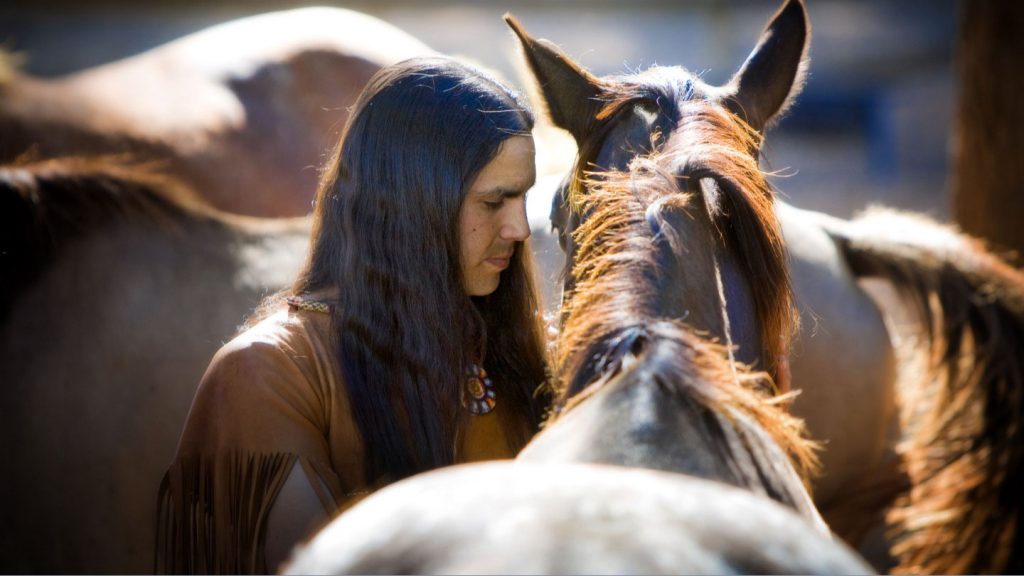Native Americans corralled Spanish horses decades before Europeans arrived

Indigenous knowledge and Western science have written a new tale about when horses most recently arrived in North America.
Spaniards brought horses to Mexico in 1519. Indigenous peoples then took the reins, rapidly transporting offspring of those equine newcomers north along trade routes. As a result, a new study finds, many Native American populations across the Great Plains and the Rockies had incorporated horses into their ways of life by the early 1600s, decades before encountering any Europeans.
This unconventional scenario of how domesticated horses originally spread throughout central and western North America bucks a previous narrative: European written accounts dating mainly to the 1700s and 1800s had contended that horses first spread into North America in large numbers after Pueblo people temporarily drove Spanish settlers out of New Mexico in 1680. But little evidence existed to confirm or deny that claim.
Europeans’ historical texts didn’t ring true for molecular archaeologist Yvette Running Horse Collin of the Center for Anthropobiology and Genomics of Toulouse in France. Running Horse Collin is a member of the Oglala Lakota Nation. Great Plains populations such as the Lakota and Comanche speak of having cared for, herded and otherwise interacted with horses long before Europeans showed up.
Running Horse Collin contacted Toulouse colleague Ludovic Orlando, a molecular archaeologist who has traced the origins of domesticated horses to southwestern Asia more than 4,200 years ago (SN: 10/20/21). The duo organized a large collaboration of Western scientists and Indigenous scholars and officials, including members of the Lakota, Comanche, Pawnee and Pueblo Nations.
“Our findings indicate that horses spread from Mexico into North America by the turn of the 17th century and were raised locally, which strikingly lines up with Native American perspectives,” archaeozoologist William Taylor of the University of Colorado Boulder said at a March 28 news conference. Results of their investigation appear in the March 31 Science.
Taylor directed an effort that located and radiocarbon-dated previously excavated remains of 23 horses from western North America and six horses from Argentina. Three of the North American horses dated to the second half of the 1500s, well before the 1680 Pueblo Revolt. Those specimens came from sites in Kansas, New Mexico and Wyoming. Reanalysis of a previously radiocarbon-dated horse’s remains from an Idaho site, using a technique that measures the amount of near-infrared radiation absorbed by bone, produced a comparably early age estimate.
What’s particularly important is that those finds yielded evidence of Native American groups caring for, riding and culturally embracing horses by the early 1600s, says archaeologist Mark Mitchell of the Paleocultural Research Group in Broomfield, Colo., who did not participate in the new study.
The earliest North American horse remains include bony growths at the back of the skull consistent with the use of a halter or bridle, Taylor said. One horse from the 1500s displayed the kind of dental damage seen from use of a bridle’s metal bit. Another early horse had been found among various ritual artifacts, indicating that it had held ceremonial meaning of some kind.
Analyses of diet-related chemical elements in teeth typical of particular geographic regions indicated that one early North American horse had grown up locally. Another was raised even farther north, probably part of a managed herd that was fed maize during part of the year, the researchers say.
DNA comparisons with a range of modern horses showed that early North American horses were primarily of Spanish ancestry.
Some Indigenous oral histories suggest that their interactions with horses go back thousands of years to equines that might have survived the Ice Age. But analysis of DNA retrieved from remains of two Ice Age horses previously found in Alaska — one dating to about 26,100 years ago and another to around 28,400 years ago — showed no direct ties to later North American horses. Scientists generally suspect that wild horses first evolved in North America over tens of millions of years before dying out around 10,000 years ago.
For now, the scientific evidence just supports the pre-European integration of horses into Great Plains societies, says University of Oxford archaeologist Peter Mitchell, who was not part of the new investigation. Further research needs to establish precisely how long ancient wild horses survived in Alaska, he says.
Taylor and his colleagues have nonetheless married Western science to Indigenous knowledge in a way that “sets a new standard for archaeological research into the early spread of the horse and the take-up of horse usage by Indigenous groups” throughout the world, Mitchell says.



